engine INFINITI Q50 2018 Owner's Manual
[x] Cancel search | Manufacturer: INFINITI, Model Year: 2018, Model line: Q50, Model: INFINITI Q50 2018Pages: 458, PDF Size: 2.13 MB
Page 328 of 458

6 In case of emergency
Hazard warning flasher switch...................................... 6-2
Roadside assistance program......................................... 6-2
Emergency engine shut off............................................. 6-3
Flat tire ........................................................................\
......... 6-3Tire Pressure Monitoring System (TPMS) ............ 6-3
Run-flat tires (if so equipped)................................... 6-4
Changing a flat tire...................................................... 6-4 Jump starting ..................................................................... 6-9
Main battery (for all models) ................................ 6-12
Auxiliary battery (for 2.0L turbo gasoline
engine models)........................................................... 6-14
Push starting .................................................................... 6-16
If your vehicle overheats............................................... 6-16
Towing your vehicle........................................................ 6-17 Towing recommended by INFINITI..................... 6-18
Vehicle recovery (freeing a stuck vehicle) ......... 6-19
Page 330 of 458
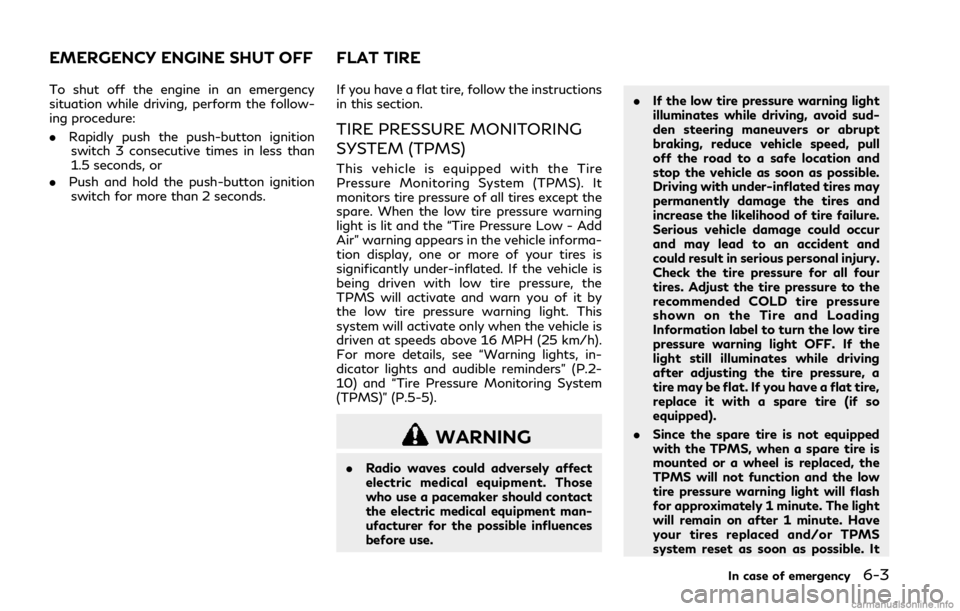
To shut off the engine in an emergency
situation while driving, perform the follow-
ing procedure:
.Rapidly push the push-button ignition
switch 3 consecutive times in less than
1.5 seconds, or
. Push and hold the push-button ignition
switch for more than 2 seconds. If you have a flat tire, follow the instructions
in this section.
TIRE PRESSURE MONITORING
SYSTEM (TPMS)
This vehicle is equipped with the Tire
Pressure Monitoring System (TPMS). It
monitors tire pressure of all tires except the
spare. When the low tire pressure warning
light is lit and the “Tire Pressure Low - Add
Air” warning appears in the vehicle informa-
tion display, one or more of your tires is
significantly under-inflated. If the vehicle is
being driven with low tire pressure, the
TPMS will activate and warn you of it by
the low tire pressure warning light. This
system will activate only when the vehicle is
driven at speeds above 16 MPH (25 km/h).
For more details, see “Warning lights, in-
dicator lights and audible reminders” (P.2-
10) and “Tire Pressure Monitoring System
(TPMS)” (P.5-5).
WARNING
.
Radio waves could adversely affect
electric medical equipment. Those
who use a pacemaker should contact
the electric medical equipment man-
ufacturer for the possible influences
before use. .
If the low tire pressure warning light
illuminates while driving, avoid sud-
den steering maneuvers or abrupt
braking, reduce vehicle speed, pull
off the road to a safe location and
stop the vehicle as soon as possible.
Driving with under-inflated tires may
permanently damage the tires and
increase the likelihood of tire failure.
Serious vehicle damage could occur
and may lead to an accident and
could result in serious personal injury.
Check the tire pressure for all four
tires. Adjust the tire pressure to the
recommended COLD tire pressure
shown on the Tire and Loading
Information label to turn the low tire
pressure warning light OFF. If the
light still illuminates while driving
after adjusting the tire pressure, a
tire may be flat. If you have a flat tire,
replace it with a spare tire (if so
equipped).
. Since the spare tire is not equipped
with the TPMS, when a spare tire is
mounted or a wheel is replaced, the
TPMS will not function and the low
tire pressure warning light will flash
for approximately 1 minute. The light
will remain on after 1 minute. Have
your tires replaced and/or TPMS
system reset as soon as possible. It
In case of emergency6-3
EMERGENCY ENGINE SHUT OFF FLAT TIRE
Page 331 of 458
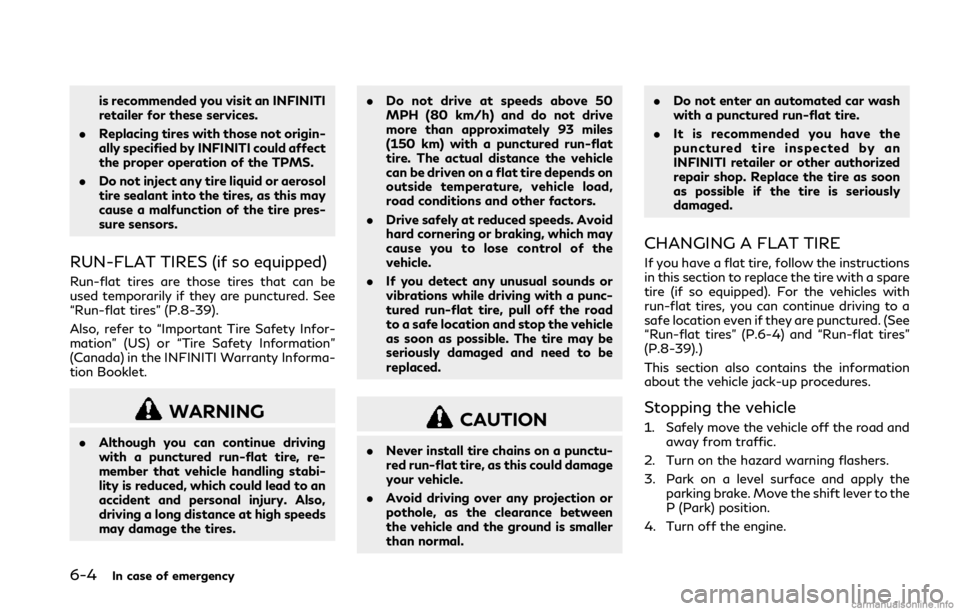
6-4In case of emergency
is recommended you visit an INFINITI
retailer for these services.
. Replacing tires with those not origin-
ally specified by INFINITI could affect
the proper operation of the TPMS.
. Do not inject any tire liquid or aerosol
tire sealant into the tires, as this may
cause a malfunction of the tire pres-
sure sensors.
RUN-FLAT TIRES (if so equipped)
Run-flat tires are those tires that can be
used temporarily if they are punctured. See
“Run-flat tires” (P.8-39).
Also, refer to “Important Tire Safety Infor-
mation” (US) or “Tire Safety Information”
(Canada) in the INFINITI Warranty Informa-
tion Booklet.
WARNING
.Although you can continue driving
with a punctured run-flat tire, re-
member that vehicle handling stabi-
lity is reduced, which could lead to an
accident and personal injury. Also,
driving a long distance at high speeds
may damage the tires. .
Do not drive at speeds above 50
MPH (80 km/h) and do not drive
more than approximately 93 miles
(150 km) with a punctured run-flat
tire. The actual distance the vehicle
can be driven on a flat tire depends on
outside temperature, vehicle load,
road conditions and other factors.
. Drive safely at reduced speeds. Avoid
hard cornering or braking, which may
cause you to lose control of the
vehicle.
. If you detect any unusual sounds or
vibrations while driving with a punc-
tured run-flat tire, pull off the road
to a safe location and stop the vehicle
as soon as possible. The tire may be
seriously damaged and need to be
replaced.
CAUTION
.Never install tire chains on a punctu-
red run-flat tire, as this could damage
your vehicle.
. Avoid driving over any projection or
pothole, as the clearance between
the vehicle and the ground is smaller
than normal. .
Do not enter an automated car wash
with a punctured run-flat tire.
. It is recommended you have the
punctured tire inspected by an
INFINITI retailer or other authorized
repair shop. Replace the tire as soon
as possible if the tire is seriously
damaged.
CHANGING A FLAT TIRE
If you have a flat tire, follow the instructions
in this section to replace the tire with a spare
tire (if so equipped). For the vehicles with
run-flat tires, you can continue driving to a
safe location even if they are punctured. (See
“Run-flat tires” (P.6-4) and “Run-flat tires”
(P.8-39).)
This section also contains the information
about the vehicle jack-up procedures.
Stopping the vehicle
1. Safely move the vehicle off the road and
away from traffic.
2. Turn on the hazard warning flashers.
3. Park on a level surface and apply the parking brake. Move the shift lever to the
P (Park) position.
4. Turn off the engine.
Page 333 of 458
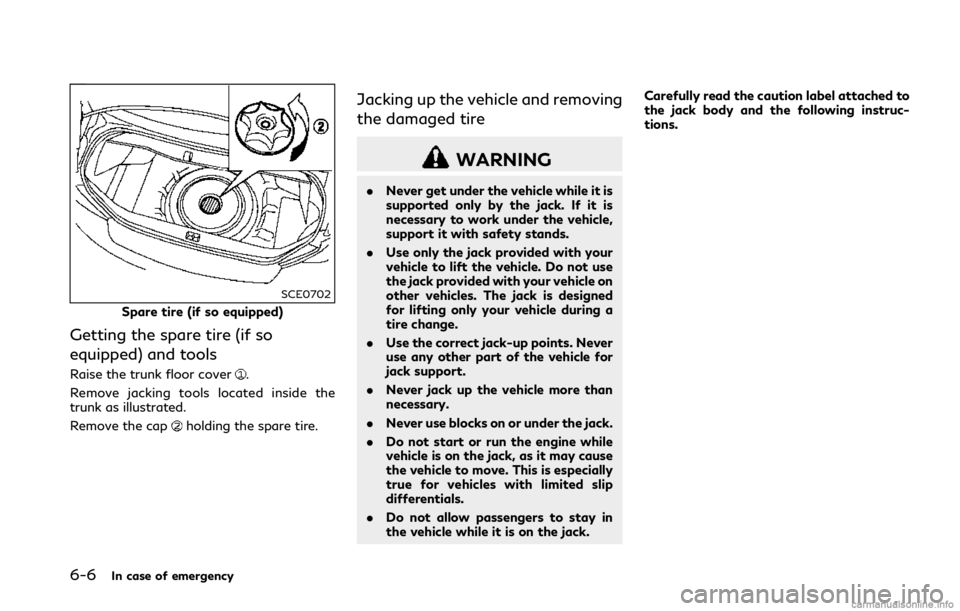
6-6In case of emergency
SCE0702
Spare tire (if so equipped)
Getting the spare tire (if so
equipped) and tools
Raise the trunk floor cover.
Remove jacking tools located inside the
trunk as illustrated.
Remove the cap
holding the spare tire.
Jacking up the vehicle and removing
the damaged tire
WARNING
. Never get under the vehicle while it is
supported only by the jack. If it is
necessary to work under the vehicle,
support it with safety stands.
. Use only the jack provided with your
vehicle to lift the vehicle. Do not use
the jack provided with your vehicle on
other vehicles. The jack is designed
for lifting only your vehicle during a
tire change.
. Use the correct jack-up points. Never
use any other part of the vehicle for
jack support.
. Never jack up the vehicle more than
necessary.
. Never use blocks on or under the jack.
. Do not start or run the engine while
vehicle is on the jack, as it may cause
the vehicle to move. This is especially
true for vehicles with limited slip
differentials.
. Do not allow passengers to stay in
the vehicle while it is on the jack. Carefully read the caution label attached to
the jack body and the following instruc-
tions.
Page 336 of 458
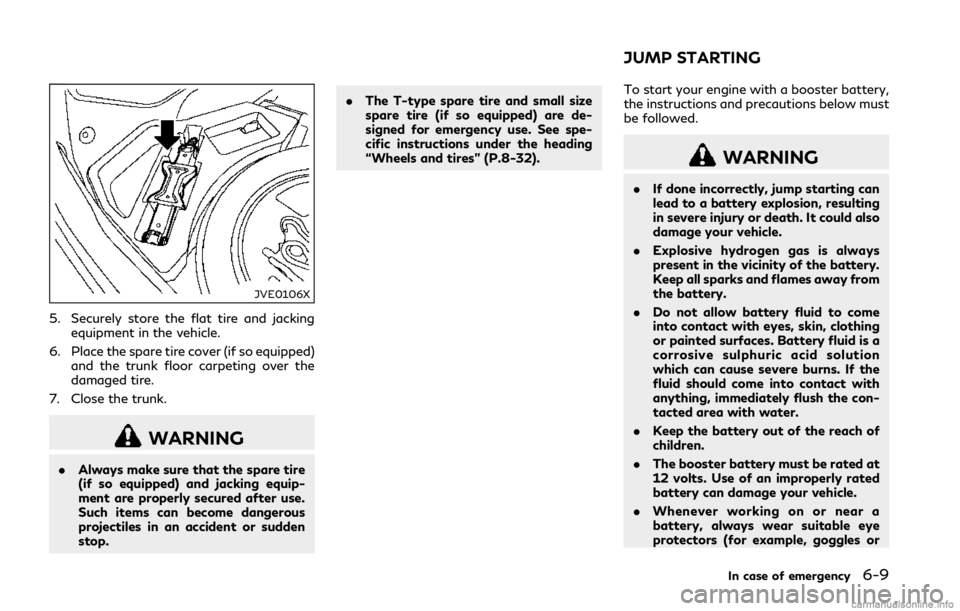
JVE0106X
5. Securely store the flat tire and jackingequipment in the vehicle.
6. Place the spare tire cover (if so equipped) and the trunk floor carpeting over the
damaged tire.
7. Close the trunk.
WARNING
. Always make sure that the spare tire
(if so equipped) and jacking equip-
ment are properly secured after use.
Such items can become dangerous
projectiles in an accident or sudden
stop. .
The T-type spare tire and small size
spare tire (if so equipped) are de-
signed for emergency use. See spe-
cific instructions under the heading
“Wheels and tires” (P.8-32). To start your engine with a booster battery,
the instructions and precautions below must
be followed.
WARNING
.
If done incorrectly, jump starting can
lead to a battery explosion, resulting
in severe injury or death. It could also
damage your vehicle.
. Explosive hydrogen gas is always
present in the vicinity of the battery.
Keep all sparks and flames away from
the battery.
. Do not allow battery fluid to come
into contact with eyes, skin, clothing
or painted surfaces. Battery fluid is a
corrosive sulphuric acid solution
which can cause severe burns. If the
fluid should come into contact with
anything, immediately flush the con-
tacted area with water.
. Keep the battery out of the reach of
children.
. The booster battery must be rated at
12 volts. Use of an improperly rated
battery can damage your vehicle.
. Whenever working on or near a
battery, always wear suitable eye
protectors (for example, goggles or
In case of emergency6-9
JUMP STARTING
Page 337 of 458
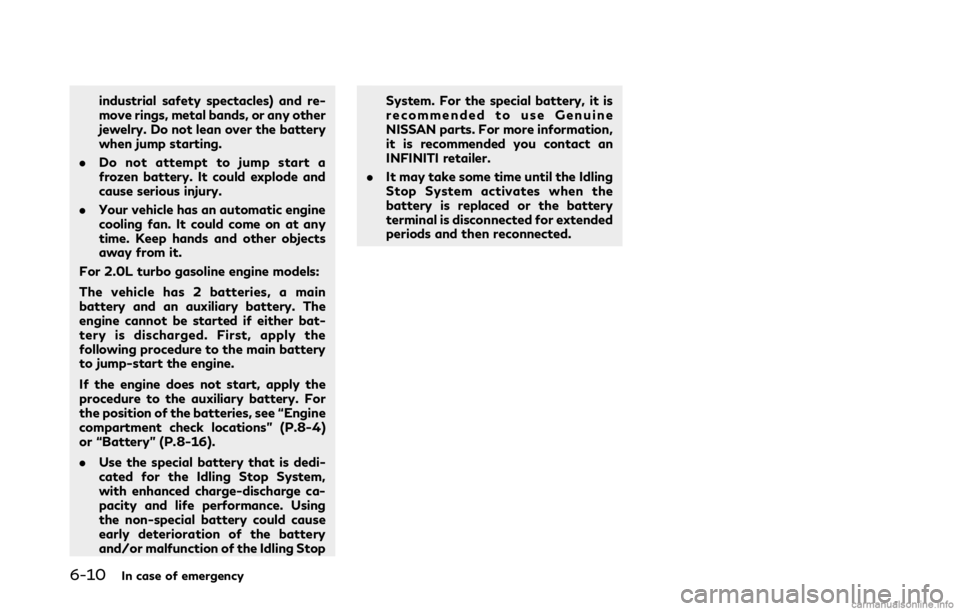
6-10In case of emergency
industrial safety spectacles) and re-
move rings, metal bands, or any other
jewelry. Do not lean over the battery
when jump starting.
. Do not attempt to jump start a
frozen battery. It could explode and
cause serious injury.
. Your vehicle has an automatic engine
cooling fan. It could come on at any
time. Keep hands and other objects
away from it.
For 2.0L turbo gasoline engine models:
The vehicle has 2 batteries, a main
battery and an auxiliary battery. The
engine cannot be started if either bat-
tery is discharged. First, apply the
following procedure to the main battery
to jump-start the engine.
If the engine does not start, apply the
procedure to the auxiliary battery. For
the position of the batteries, see “Engine
compartment check locations” (P.8-4)
or “Battery” (P.8-16).
. Use the special battery that is dedi-
cated for the Idling Stop System,
with enhanced charge-discharge ca-
pacity and life performance. Using
the non-special battery could cause
early deterioration of the battery
and/or malfunction of the Idling Stop System. For the special battery, it is
recommended to use Genuine
NISSAN parts. For more information,
it is recommended you contact an
INFINITI retailer.
. It may take some time until the Idling
Stop System activates when the
battery is replaced or the battery
terminal is disconnected for extended
periods and then reconnected.
Page 338 of 458

JVE0282X
VR30DDTT engine
In case of emergency6-11
Page 339 of 458
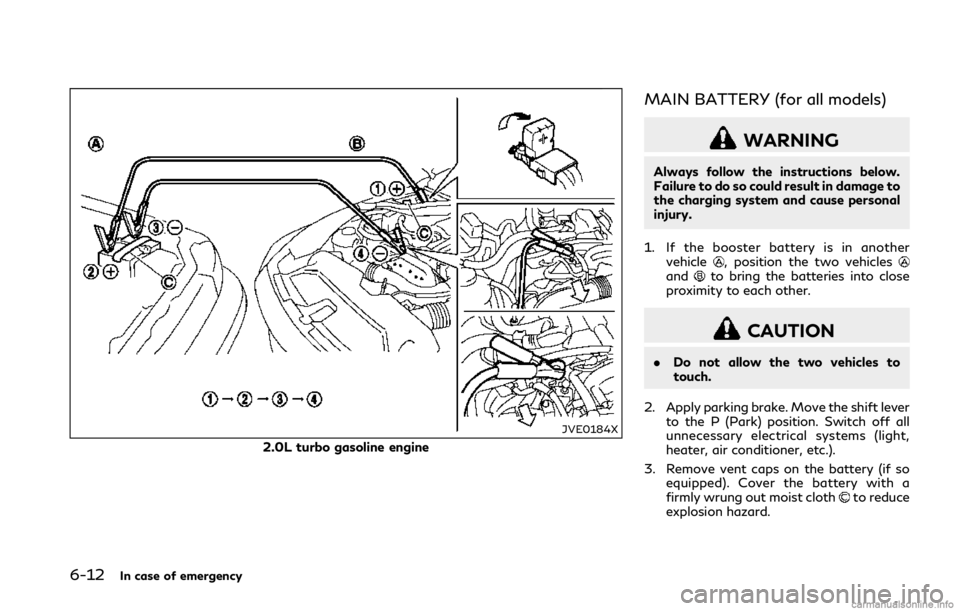
6-12In case of emergency
JVE0184X
2.0L turbo gasoline engine
MAIN BATTERY (for all models)
WARNING
Always follow the instructions below.
Failure to do so could result in damage to
the charging system and cause personal
injury.
1. If the booster battery is in another vehicle
, position the two vehiclesandto bring the batteries into close
proximity to each other.
CAUTION
. Do not allow the two vehicles to
touch.
2. Apply parking brake. Move the shift lever to the P (Park) position. Switch off all
unnecessary electrical systems (light,
heater, air conditioner, etc.).
3. Remove vent caps on the battery (if so equipped). Cover the battery with a
firmly wrung out moist cloth
to reduce
explosion hazard.
Page 340 of 458

JVE0194X
2.0L turbo gasoline engine
4. For 2.0L turbo gasoline engine model:
Pull up the engine cover and remove it.
5. Connect jumper cables in the sequence as illustrated (
???).
CAUTION
.Always connect positive (+) to posi-
tive (+) and negative (−) to body
ground (as illustrated) − not to the
battery.
. Make sure the jumper cables do not
touch moving parts in the engine
compartment and that clamps do
not contact any other metal. 6. Start the engine of the booster vehicle
and let it run for a few minutes.
7. Keep the engine speed of the booster vehicle
at about 2,000 rpm, and start
the engine of the vehicle being jump
started
.
CAUTION
Do not keep the starter motor engaged
for more than 10 seconds. If the engine
does not start right away, push the
ignition switch to the OFF position and
wait 10 seconds before trying again.
8. After starting your engine, carefully disconnect the negative cable and then
the positive cable (
???).
9. Replace the vent caps (if so equipped). Be sure to dispose of the cloth used to
cover the vent holes as it may be
contaminated with corrosive acid.
10. Put the battery cover and the engine cover back to the original location.
NOTE:
For 2.0L turbo gasoline engine models, if
the engine cannot be started after the
procedure above, the auxiliary battery
may be discharged. Connect the jumper cables to the auxiliary battery and apply
the procedure shown in “Auxiliary battery
(for 2.0L turbo gasoline engine models)”
(P.6-14).
In case of emergency6-13
Page 341 of 458

6-14In case of emergency
JVE0142X
2.0L turbo gasoline engine
AUXILIARY BATTERY (for 2.0L
turbo gasoline engine models)
1. If the booster battery is in anothervehicle, position the two vehiclesandto bring the batteries into close
proximity to each other.
CAUTION
. Do not allow the two vehicles to
touch.
2. Apply the parking brake. 3. Move the shift lever to the “P” (Park)
position.
4. Switch off all unnecessary electrical systems (headlights, heater, air condi-
tioner, etc.).
5. Push the ignition switch to the “OFF” position.